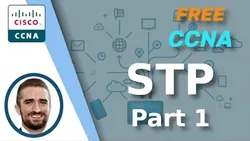
Free CCNA Spanning Tree Protocol (Part 1) Day 20 CCNA 200-301 Complete Course 
This course covers the basics of the Spanning Tree Protocol (STP), a network redundancy protocol used to prevent layer 2 loops and broadcast storms. It introduces hubs, bridges, and switches, and demonstrates how STP works. It also explains how STP BPDUs are used to elect a root bridge. ▼
ADVERTISEMENT
Course Feature
![]() Cost:
Cost:
Free
![]() Provider:
Provider:
Youtube
![]() Certificate:
Certificate:
Paid Certification
![]() Language:
Language:
English
![]() Start Date:
Start Date:
On-Demand
Course Overview
❗The content presented here is sourced directly from Youtube platform. For comprehensive course details, including enrollment information, simply click on the 'Go to class' link on our website.
Updated in [February 21st, 2023]
Introduction.
Things we'll cover.
Network Redundancy.
Layer 2 Loops (Broadcast Storms).
STP Intro.
Hubs, bridges, and switches.
STP Demonstration.
STP Intro (cont.).
STP BPDUs, Root Bridge election.
Root Bridge election demo.
PVST, Extended System ID.
Root Bridge (cont.).
STP Quiz 1 (identify the Root Bridge).
STP Quiz 2 (identify the Root Bridge).
STP Port Role selection (Root Port selection via Root Cost).
Root Cost.
STP Port Role selection (Root Port selection via Neighbor Bridge ID).
STP Quiz 3 (Identify Root Bridge, Root Ports).
STP Port Role selection (Root Port selection via Neighbor Port ID).
STP Quiz 4 (Identify Root Port).
Blocking Ports to prevent loops.
Non-Designated Port selection.
STP Process Summary.
STP Quiz 5 (Identify Root Bridge, Port Roles).
STP Quiz 6 (Identify Root Bridge, Port Roles).
Boson ExSim.
(Please note that we obtained the following content based on information that users may want to know, such as skills, applicable scenarios, future development, etc., combined with AI tools, and have been manually reviewed)
This course provides an introduction to the Spanning Tree Protocol (STP), a network redundancy protocol used to prevent Layer 2 loops and broadcast storms. It covers topics such as network redundancy, hubs, bridges, and switches, root bridge election, port role selection, and blocking ports to prevent loops.
Possible Development Paths include pursuing a career in network engineering, network administration, or network security. Learners may also choose to pursue a degree in computer science, information technology, or a related field.
Learning Suggestions for learners include studying related topics such as network topology, network design, and network security. Learners should also practice troubleshooting and configuring networks using STP. Additionally, learners should practice taking quizzes and exams to test their understanding of the material.
Course Provider

Provider Youtube's Stats at AZClass
Discussion and Reviews
0.0 (Based on 0 reviews)
Explore Similar Online Courses

Tutorial: an illustration from A to Z with Krita

How to use Pixlr X - Easy Graphic Design

Python for Informatics: Exploring Information

Social Network Analysis

Introduction to Systematic Review and Meta-Analysis

The Analytics Edge

DCO042 - Python For Informatics

Causal Diagrams: Draw Your Assumptions Before Your Conclusions

Whole genome sequencing of bacterial genomes - tools and applications

CCNA (Cisco Certified Network Associate) Course

Packet Tracer labs for the CCNA 200-301 exam: Practical labs


Start your review of Free CCNA Spanning Tree Protocol (Part 1) Day 20 CCNA 200-301 Complete Course